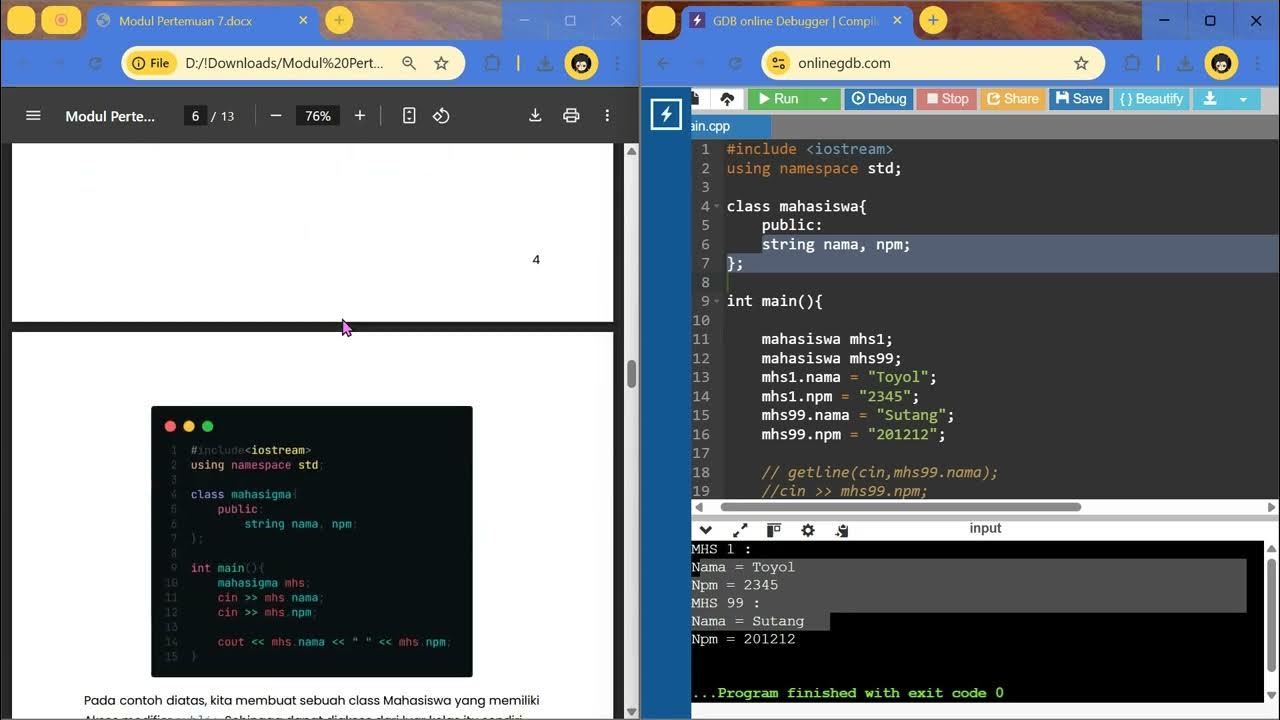8. Named Constructor
Summary
TLDRIn this video, the presenter explains the concept of named constructors in programming. A constructor is a function with the same name as the class, typically used for object initialization. The video demonstrates how, in certain programming languages, a named constructor allows multiple constructors with different names, making it possible to customize object creation. The presenter showcases an example with a 'Car' class, using named constructors to change properties like 'brand' and 'color'. The tutorial emphasizes the importance of unique names for each constructor while keeping the code simple and efficient.
Takeaways
- 😀 A constructor is a special function in programming whose name must be the same as the class name.
- 😀 Only one constructor can be created in a class with the same name, but you cannot create multiple constructors with the same name in a class.
- 😀 In most languages, constructors follow the same rule as methods, where methods cannot have the same name in a class.
- 😀 The concept of named constructors allows you to have multiple constructors in a class, but with different names.
- 😀 A named constructor can be defined by using the class name followed by a dot and the name of the constructor.
- 😀 You can create multiple constructors to perform different actions, such as changing different properties (e.g., 'brand' or 'color').
- 😀 The constructor's implementation must differ, or it won't be possible to define multiple constructors with the same name.
- 😀 When creating an object using a constructor, you can specify values for different properties of the object.
- 😀 In the example, the brand property of a car object was changed using a named constructor, demonstrating how named constructors work.
- 😀 The script shows that after creating an object and calling the constructor, you can print the changed value of a property to verify it.
- 😀 The key takeaway is that named constructors provide more flexibility in managing object creation with different initializations.
Q & A
What is a constructor in programming?
-A constructor is a special function whose name must be the same as the name of the class. It is used to initialize objects of that class.
Can you have multiple constructors with the same name in a class?
-No, you cannot have multiple constructors with the same name in a class because the constructor name must match the class name. However, you can use named constructors in some languages to create multiple constructors with different names.
What happens if you try to create more than one constructor with the same name in a class?
-If you attempt to create more than one constructor with the same name, it will result in an error, as the constructor name must be unique and match the class name.
What is the purpose of named constructors in programming?
-Named constructors allow you to create more than one constructor within a class, but with different names. This enables you to have multiple constructors, each designed to handle different types of initialization.
How do you define a named constructor in a class?
-To define a named constructor, you specify the name of the class followed by a dot and then provide a unique name for the constructor. For example, 'className.constructorName()'.
Can you have multiple constructors with the same name but different parameters in a class?
-Yes, in languages that support method overloading or constructor overloading, you can have multiple constructors with the same name but different parameters, as long as the parameter types or number of parameters differ.
What is the difference between constructors and methods in a class?
-A constructor is a special function that initializes objects when they are created, whereas a method is a function that defines behaviors or operations on an object. Methods can have any name, while constructors must match the class name.
How can you implement a constructor that only changes one property of an object?
-You can define a named constructor that takes the desired property value as an argument and then updates the corresponding property of the object. For example, a constructor that takes a 'brand' argument and sets the 'brand' property of a car object.
What should you do to create an object using a constructor?
-To create an object using a constructor, you first instantiate the class with the constructor, passing the required arguments. For example, 'new Car(brand)' where 'Car' is the class and 'brand' is an argument.
How do you verify if a constructor has correctly initialized the object properties?
-You can verify if the constructor has correctly initialized the object properties by printing the object's properties to the console or logging them in the program. If the constructor works correctly, the printed values will match the initialized values.
Outlines

Этот раздел доступен только подписчикам платных тарифов. Пожалуйста, перейдите на платный тариф для доступа.
Перейти на платный тарифMindmap

Этот раздел доступен только подписчикам платных тарифов. Пожалуйста, перейдите на платный тариф для доступа.
Перейти на платный тарифKeywords

Этот раздел доступен только подписчикам платных тарифов. Пожалуйста, перейдите на платный тариф для доступа.
Перейти на платный тарифHighlights

Этот раздел доступен только подписчикам платных тарифов. Пожалуйста, перейдите на платный тариф для доступа.
Перейти на платный тарифTranscripts

Этот раздел доступен только подписчикам платных тарифов. Пожалуйста, перейдите на платный тариф для доступа.
Перейти на платный тарифПосмотреть больше похожих видео

Inheritance (Pewarisan), Konsep Constructor inheritance Pada Kotlin

5. Constructor

Ambiguity Problem and its Solution with Constructor Injection | Spring Framework Tutorial

☕️ Curso de Java na prática - Construtores - aula 7 - POO - Parte 2/7 #java #javase #javatutorial

Pertemuan 7 Pemrograman Terstruktur 2025

Class Objects & Constructors | Godot GDScript Tutorial | Ep 16
5.0 / 5 (0 votes)
